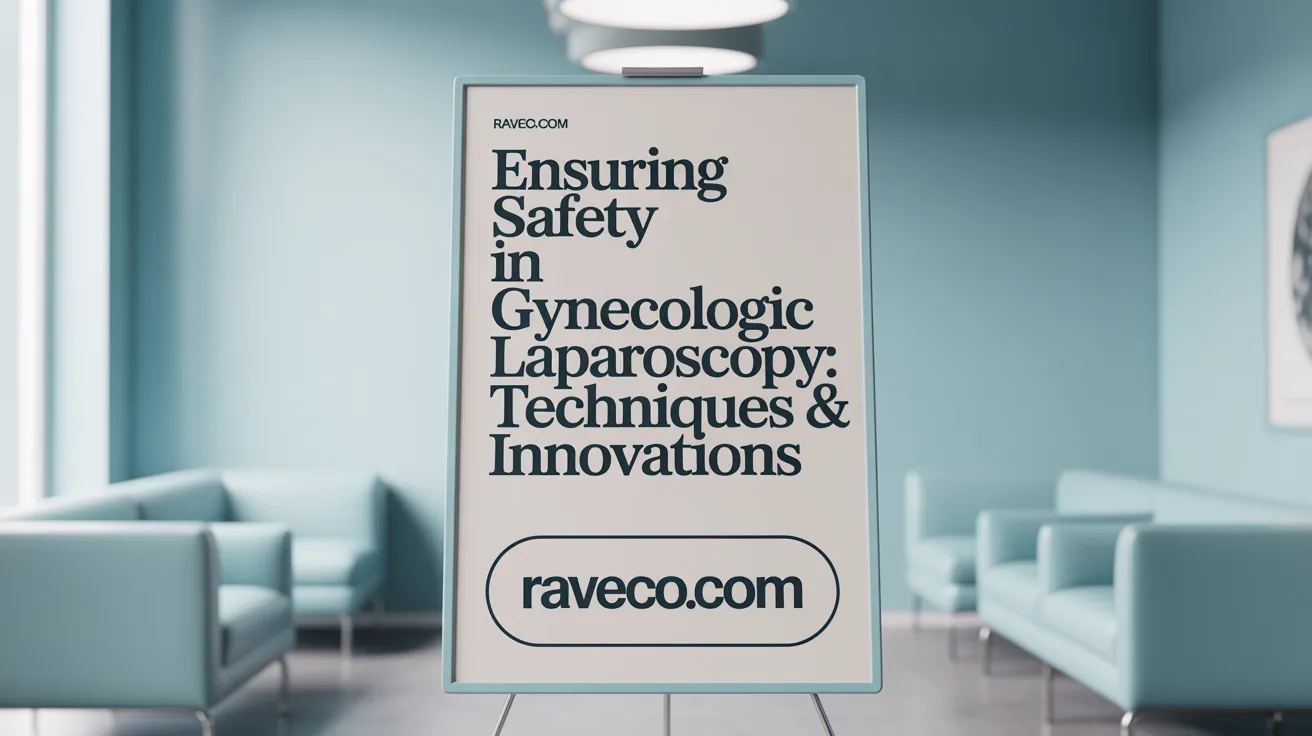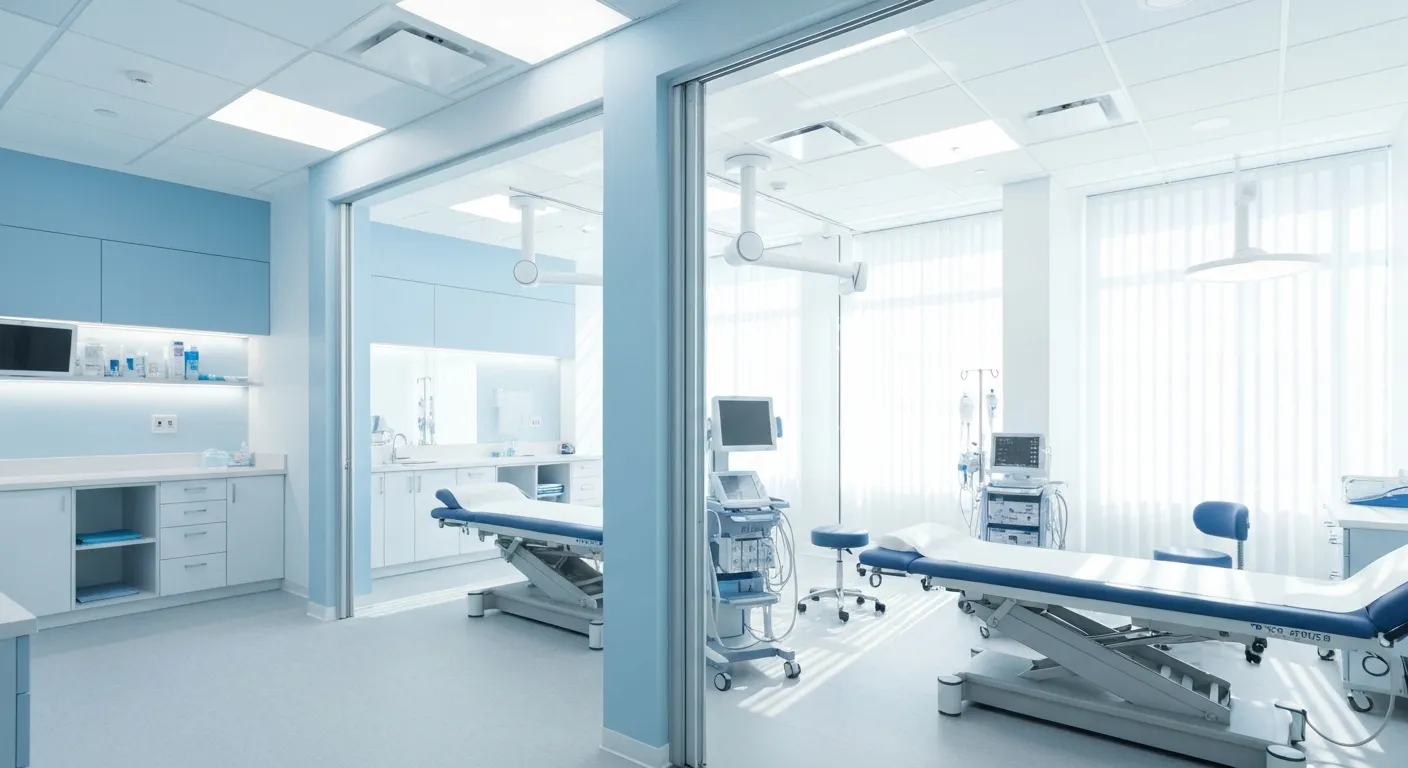Transforming Women's Health: The Advantage of Minimally Invasive Gynecologic Surgery

Overview of Laparoscopic Surgery in Gynecological Care
What is Laparoscopic Surgery?
Laparoscopic surgery is a minimally invasive procedure that uses tiny incisions, typically about half an inch, to allow surgeons to diagnose and treat gynecological conditions with the help of a thin, lighted instrument called a laparoscope.
Benefits of Laparoscopy
This technique offers many advantages over traditional open surgery, including reduced pain, smaller scars, less blood loss, and faster recovery times. It also lowers the risk of infection and allows many patients to return home the same day or after a short hospital stay.
Common Gynecological Conditions Treated
Laparoscopy is used to manage a range of conditions such as ovarian cysts, fibroids, endometriosis, pelvic pain, and ectopic pregnancy. It is also employed for procedures like hysterectomy, myomectomy, and tubal ligation.
Preference Over Open Surgery
Compared to open surgery, laparoscopy results in less trauma to the body, quicker healing, and fewer complications. The precision of the laparoscope reduces damage to surrounding tissues, making it a safer, more efficient choice for many women seeking gynecological care.
Comprehensive Services Offered by Woman-Led Obstetrics and Gynecology Providers

What services does a woman-led healthcare provider specializing in comprehensive obstetrics and gynecology typically offer?
A woman-led obstetrics and gynecology practice provides a full range of services addressing women's health through every phase of life. These offerings include routine gynecological checkups, cervical cancer screening, bone densitometry, and management of menstrual and hormonal issues.
Prenatal care is a core component, focusing on regular check-ups, 4-D obstetrical ultrasound, high-risk pregnancy management, and preparation for childbirth. Postpartum care ensures support after delivery for both mother and newborn.
Advanced services include minimally invasive surgeries such as laparoscopy and hysteroscopy, used to treat conditions like fibroids, endometriosis, ovarian cysts, and pelvic pain. This surgical approach is integrated within personalized care plans to promote faster healing and fewer complications.
Family planning, contraceptive counseling, infertility treatment, and menopause support are also offered to meet diverse reproductive needs.
How is laparoscopic surgery integrated within personalized women's health care?
Laparoscopic surgery is a minimally invasive technique widely used by these providers to improve patient outcomes. The technology involves small incisions and advanced imaging, leading to less pain, reduced scarring, and shorter recovery times. It is tailored to individual patients’ conditions, including fibroids, endometriosis, and complicated pregnancies.
Providers employing these techniques often use advanced diagnostic tools like ultrasound and MRI for precise surgical planning. Enhanced recovery protocols and surgeon expertise ensure safety and high satisfaction.
What community and patient-centered approaches are emphasized in Queens, NY?
Women for Women OB/GYN LLC in Queens, NY, exemplifies a woman-led, community-focused practice that prioritizes personalized care. The clinic collaborates with nearby facilities, including specialized neonatal intensive care units, to support comprehensive maternal and infant health.
The practice encourages early and consistent prenatal visits and provides clear patient education to improve comfort and informed decision-making. Advanced minimally invasive surgeries are accessible locally, reducing travel burdens and fostering trust.
This community-centered approach ensures women in Queens receive compassionate, expert care tailored to their unique health circumstances and cultural needs, reinforcing the value of personalized women's healthcare services in an urban setting.
Technological Advances Driving Laparoscopic Gynecologic Surgery

Use of laparoscopes and robotic-assisted technologies
Laparoscopic gynecologic surgery relies on the use of a laparoscope, a thin, lighted instrument equipped with a camera, inserted through small incisions. This technology enables surgeons to diagnose and treat conditions such as fibroids, endometriosis, ovarian cysts, and pelvic pain with precision and minimal invasiveness. Robotic-assisted laparoscopy enhances this further by offering improved dexterity and control, allowing complex procedures like myomectomy and hysterectomy to be performed with fewer complications, less pain, and quicker recovery (Benefits of laparoscopic gynecological procedures, Robotic Laparoscopic Myomectomy Surgery Midtown NYC).
Advanced imaging techniques including ultrasound and MRI for surgical planning
Preoperative imaging plays an essential role in guiding minimally invasive gynecologic surgeries. Advances in ultrasound, including high-resolution and protocol-driven techniques like IDEA, provide sensitive and specific detection of disease such as endometriomas and deep infiltrative endometriosis. MRI complements ultrasound by offering detailed tissue characterization and staging when ultrasound findings are inconclusive. These imaging advances allow better surgical planning, reducing the need for extensive exploratory surgery and enabling tailored approaches that improve patient outcomes (Recent advances in benign gynecological laparoscopy).
Emerging surgical methods like single-incision laparoscopy and transvaginal natural orifice transluminal endoscopic surgery (vNOTES)
Beyond traditional laparoscopy, newer techniques such as single-incision laparoscopic surgery (SILS) and transvaginal natural orifice transluminal endoscopic surgery (vNOTES) are emerging. SILS operates through a single small abdominal incision, minimizing visible scarring and postoperative pain. vNOTES combines benefits of vaginal and laparoscopic surgeries without external incisions, promoting faster healing and recovery. Though promising, these approaches require further research to fully establish safety profiles and ideal patient selection (Minimally invasive gynecologic surgery benefits, Minimally invasive gynecologic surgery).
What are some advanced technologies used in modern obstetrics and gynecology practices?
Modern obstetrics and gynecology embrace advanced technologies including 3D and 4D ultrasound imaging for detailed visualization, minimally invasive surgeries like laparoscopy and robotic assistance for precise procedures, and improved fetal monitoring systems during labor. Additionally, telemedicine supports personalized, accessible care for women, exemplifying the integration of technology to enhance women's health services in Queens, NY (Women for Women OB/GYN LLC in Queens, Minimally invasive gynecologic surgery).
These technological advances collectively improve the safety, effectiveness, and patient experience of gynecologic care, supporting a patient-centered approach with faster recovery and reduced complications (Laparoscopic surgery overview, Minimally invasive gynecologic surgery).
Clinical Benefits and Patient Outcomes with Laparoscopic Surgery

Reduced pain, smaller scars, faster recovery and fewer complications
Laparoscopic surgery offers significant clinical benefits over traditional open procedures. The use of tiny incisions, typically about half an inch, leads to less tissue trauma and reduced postoperative pain. Patients experience smaller scars which are cosmetically favorable and less prone to infection. This minimally invasive approach enables faster recovery times, allowing most women to return to normal activities within days to a few weeks. Additionally, laparoscopic techniques reduce intraoperative blood loss and lower the risk of complications such as infections and hernias.
Benefits in hysterectomy, myomectomy, endometriosis and ovarian cyst treatment
Laparoscopy is effectively used to treat a wide range of benign gynecological conditions including hysterectomy (uterus removal), myomectomy (fibroid removal), endometriosis, and ovarian cysts. Compared to abdominal surgery, laparoscopic hysterectomy has demonstrated improved short-term postoperative quality of life, less pain, and shorter hospital stays. The precision offered by laparoscopic instruments and advanced imaging supports better surgical planning and tissue preservation, which contributes to reduced complications and better healing. Robotic-assisted laparoscopic procedures further enhance surgical control and accuracy, benefitting complex cases.
Impact of enhanced recovery after surgery (ERAS) protocols
The integration of Enhanced Recovery After Surgery (ERAS) protocols within laparoscopic gynecologic surgery has transformed patient care. These evidence-based pathways focus on minimizing surgical stress and optimizing perioperative management to accelerate recovery. ERAS protocols reduce hospital length of stay, decrease opioid use, and improve patient satisfaction. Facilities in Queens, NY, employing such protocols in minimally invasive gynecologic surgery observe quicker patient recovery and cost savings. Together with simulation-based surgeon training, this approach ensures safer surgeries and better outcomes.
Personalized women's health care and its role in improving outcomes
Personalized women's health care tailoring treatment plans to the individual’s unique medical history and lifestyle enhances outcomes in obstetrics and gynecology. It fosters stronger patient-provider communication, encouraging adherence to treatments and early detection strategies. By addressing patient-specific risk factors, personalized care prevents complications during pregnancy and gynecological treatments, further improving quality of life. This patient-centered approach aligns well with advanced minimally invasive surgical care, providing women in Queens, NY with safer, more effective treatment options.
Safety and Surgical Techniques in Gynecologic Laparoscopy

How do laparoscopic entry techniques compare in terms of safety?
Laparoscopic surgery starts with gaining safe access to the abdomen. The main entry methods include the Veress needle technique, the open (Hasson) technique, and direct trocar insertion. Research shows no single entry technique is significantly safer than the others. Instead, the choice often depends on the surgeon's familiarity and experience with the method. Each approach, when properly performed, maintains a low risk profile, emphasizing the importance of skilled surgical teams and careful patient selection (Recent advances in benign gynecological laparoscopy, Laparoscopic entry techniques safety comparison.
How has tissue extraction evolved in gynecologic laparoscopy?
Tissue extraction during laparoscopic procedures originally involved power morcellation to remove large specimens through small incisions. However, concerns arose after FDA warnings highlighted the risk of spreading undetected malignant cells. This led to a significant reduction in uncontained morcellation use. In response, containment systems for tissue extraction were developed and continue to be refined. These advancements help maintain minimally invasive benefits while enhancing patient safety by preventing tissue dissemination (Power morcellation restrictions and containment systems, Minimally invasive gynecological surgery benefits.
What role do barbed sutures play in laparoscopic surgeries?
Barbed sutures have revolutionized certain laparoscopic procedures, notably vaginal cuff closure and myomectomy. Their use significantly decreases operative time by eliminating the need to tie knots. Additionally, barbed sutures may reduce intraoperative blood loss and postoperative complications, contributing to improved surgical outcomes. This technology represents a practical advancement that enhances the efficiency and safety of benign gynecological laparoscopic surgeries (Barbed sutures in gynecological laparoscopy, Minimally invasive gynecological surgery benefits.
Training and Implementation Challenges in Minimally Invasive Gynecologic Surgery

Why is simulation-based laparoscopic training important?
Simulation-based training plays a vital role in enhancing surgical skills for laparoscopic gynecologic procedures. Using both low- and high-fidelity simulators, surgeons can practice complex techniques in a risk-free environment. This improves proficiency and reduces the learning curve associated with minimally invasive gynecologic surgery, ultimately enhancing patient safety and surgical outcomes.
What barriers affect the adoption of minimally invasive gynecologic surgery?
Several challenges slow the widespread use of minimally invasive gynecologic surgery. Surgeon experience is a significant factor; without specialized training and practice, performing these delicate procedures can be difficult. Additionally, limited availability of resources, including advanced surgical equipment and trained support staff, particularly impacts hospitals in less urban or under-resourced areas.
How can access to minimally invasive surgery be improved in community settings like Queens, NY?
Expanding access in diverse communities requires investment in education and technology. Strategies include increasing simulation-based training programs to raise surgeon proficiency, partnering with specialized centers for knowledge-sharing, and ensuring availability of state-of-the-art equipment. Facilities like Women for Women OB/GYN LLC in Queens exemplify how a woman-led practice combines expertise with advanced minimally invasive options to meet local patient needs effectively.
Personalized Care and Patient Experience in Minimally Invasive Gynecologic Surgery

How do patient-centric approaches influence surgical decision making?
Minimally invasive gynecologic surgery emphasizes personalized care by tailoring procedures to the individual health needs, reproductive goals, and condition severity of each patient. Surgeons collaborate with patients to select the most suitable technique—laparoscopic, robotic-assisted, or transvaginal natural orifice transluminal endoscopic surgery (vNOTES)—prioritizing safety, efficacy, and patient preferences. This shared decision-making helps optimize outcomes and patient satisfaction.
What are the benefits of outpatient or same-day discharge surgeries?
Many minimally invasive gynecologic procedures are performed on an outpatient basis or with same-day discharge, reducing hospital stays to a few hours or less. This approach minimizes exposure to hospital environments, lowers healthcare costs, and enables women to recover in the comfort of their homes. The quicker return to normal activities supported by outpatient protocols enhances overall patient well-being.
What psychosocial advantages and quality of life improvements follow laparoscopic surgery?
Postoperative recovery after laparoscopic surgery typically involves less pain, smaller scars, and faster healing, which contribute to improved physical comfort and self-image. Studies show patients experience better short-term quality of life, with significant improvements in physical functioning and reduced bodily pain in the weeks following surgery (source). Reduced hospitalization and quicker restoration of daily routines support mental health and reduce anxiety associated with prolonged recovery.
The Future of Gynecological Care: Embracing Laparoscopy for Improved Women’s Health
Comprehensive Benefits of Laparoscopic Surgery
Laparoscopic procedures have revolutionized gynecologic care with smaller incisions, reduced pain, and faster recovery times. Patients benefit from less blood loss, minimal scarring, and a lower risk of infection. These advantages lead to shorter hospital stays and quicker returns to daily activities, making laparoscopic surgery a preferred option for treating conditions like fibroids, endometriosis, ovarian cysts, and pelvic pain.
Woman-Led Providers Enhancing Personalized Care
In Queens, NY, woman-led healthcare practices focus on personalized, minimally invasive gynecologic care. These providers emphasize early and regular prenatal and gynecological care, tailoring treatment plans that incorporate advanced laparoscopic techniques. Their compassionate approach ensures patients are well-informed and supported throughout their care journey.
Empowering Patients and Innovation in Queens
Access to state-of-the-art laparoscopic surgery facilities supports informed patient decisions and improved outcomes. Continued technological advancements and education foster ongoing innovation in minimally invasive gynecologic care. This commitment provides Queens women with safer, effective options that preserve health and quality of life.




.png)